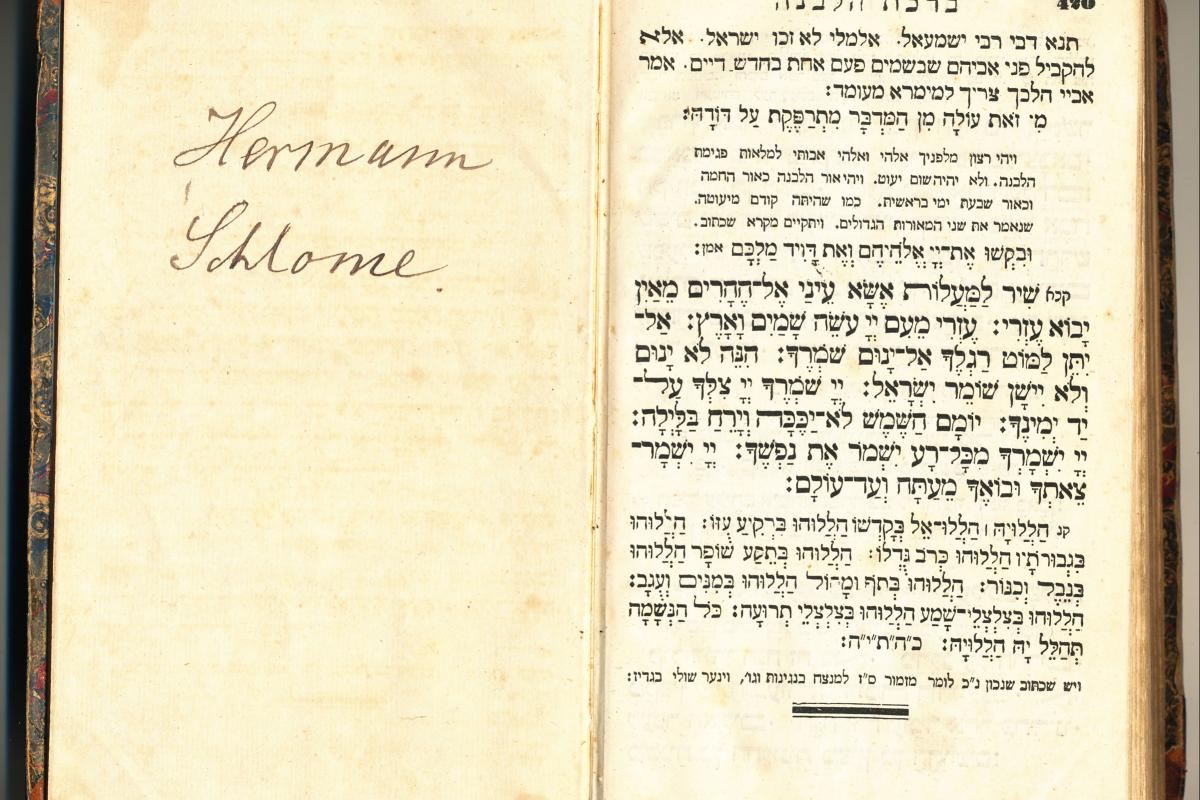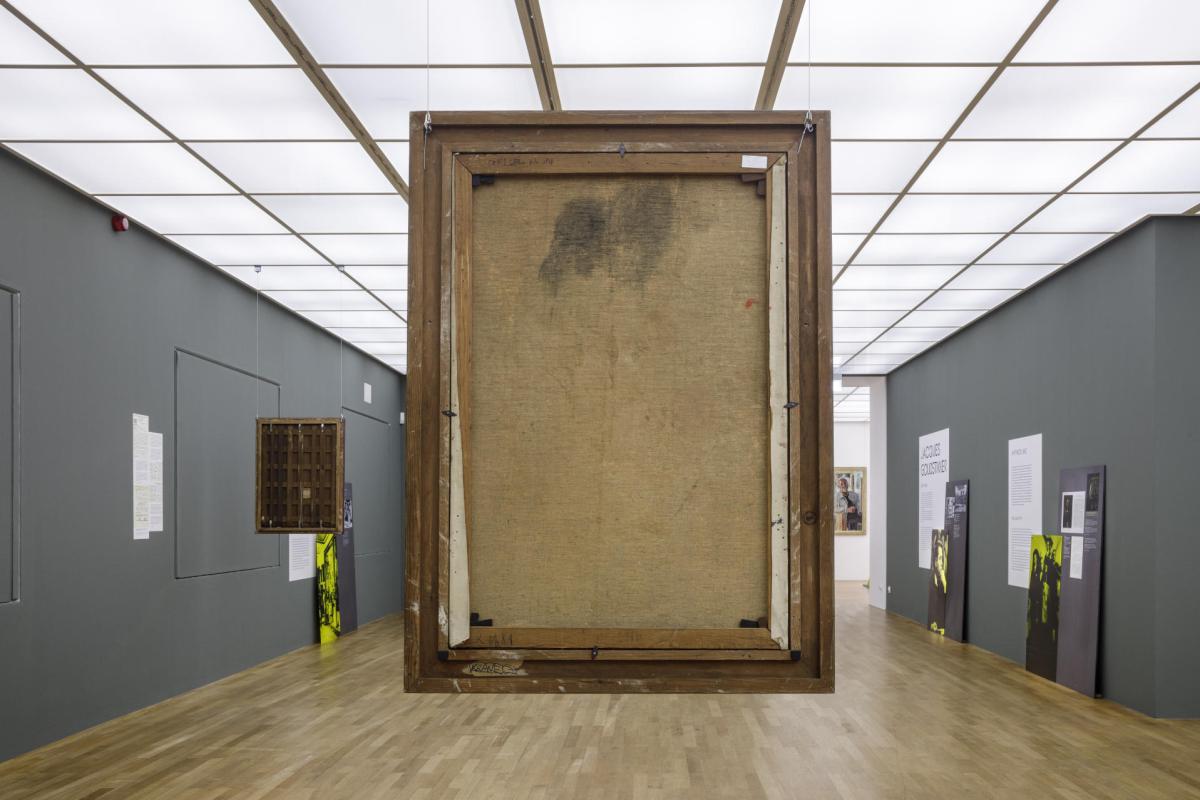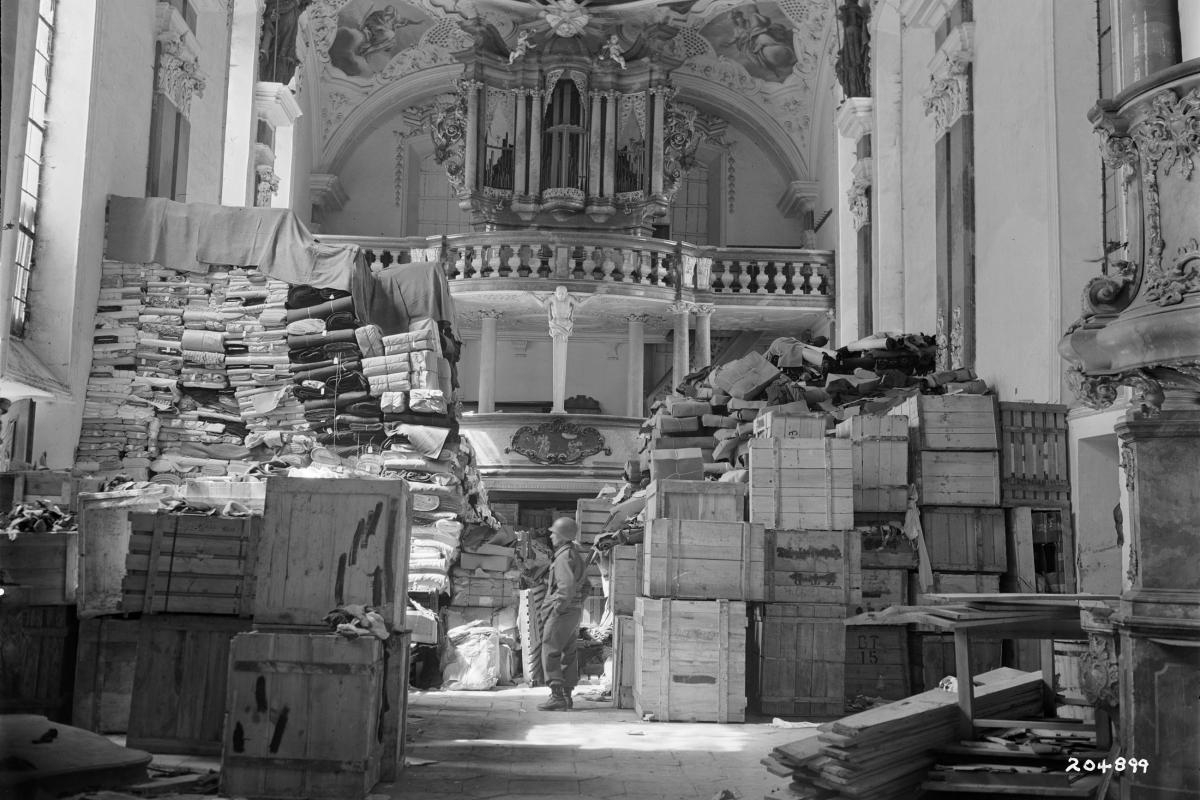Project Funding regarding Cultural Property Expropriated as a Result of Nazi Persecution
Requirements
In principle, all publicly maintained institutions in the Federal Republic of Germany – primarily museums, libraries, archives and universities – can apply for project funding from the German Lost Art Foundation. Privately funded institutions and private individuals are also eligible to apply. The requirement is that the institution or individual must declare themselves willing to arrive at a “just and fair solution” regarding the objects potentially identified as Nazi-looted cultural property as a result of the funded project in accordance with the Washington Principles and the Joint Declaration (Common Statement).
As a requirement for proposal submission, there must generally be a suspected instance of cultural property seized as a result of persecution under National Socialism. The purpose of the funding is to enable provenance research to be carried out. For this reason, the requested funds can be used to establish temporary staff positions, finance service contracts and cover material expenses such as travel costs.
Furthermore, the Foundation offers funding for projects dedicated to determining heirs. The purpose of this funding is to enable the identification of heirs to objects from collections for which provenance research has already been carried out. In this case, the preceding provenance research does not have to have been funded by the Foundation.
The Department of Cultural Property Losses in Europe in the 20th Century is the point of contact. For all questions relating to project funding:
Publicly funded institutions
Forms of project funding
Long-term research funding
It is possible to submit a proposal for a cost subsidy (shortfall funding) in connection with projects dedicated to the following: the assessment of suspected instances of Nazi-looted cultural property, the systematic investigation of holdings to identify items of cultural property seized as a result of Nazi persecution, the identification of heirs, research into the historical background of collections, the investigation of historical contexts, and the indexing, analysis and digitisation of documents and archival records. The applicant must bear a share of the project costs themselves. The amount of this contribution should reflect the size, responsible body and financial resources of the applicant. A proposal can be submitted for funding for a period of up to 24 months. It is subsequently possible to apply for a continuation of the funding for a further 12 months. As a rule, the total duration of a project should not exceed 36 months, but a term of up to 60 months is possible in certain exceptional cases. The proposal submission deadlines for long-term research funding are 1 April and 1 October each year.
Short-term research funding
It is possible to apply for full funding of a project dedicated to individual research – e.g. in the case of requests for information and restitution or in order to search for heirs – and to carry out an initial check. Here, the applicant does not usually have to contribute to financing the project themselves. Funding of up to a maximum of EUR 40,000 can be applied for. Smaller-scale inventory assessments are also eligible for funding in exceptional cases. Proposals can be submitted for funding for a period of up to six months, with no extensions permitted. A proposal for a short-term research project can be submitted at any time.
To extend your contract, please also use the “Antragsformular Förderung”.
Prepare proposal and make use of consultation services
The steps listed below provide initial guidance to help conceptualise the research project and complete the proposal submission form. In general, it is advisable to have the draft proposal checked for factual and formal correctness by the Department of Cultural Property Losses in Europe in the 20th Century in good time before the proposal submission deadline. The proposal submission deadlines for long-term research funding are 1 April and 1 October each year. Please note the deadlines of drafts on 1 March and 1 September each year.
German Lostart Foundation
Cathleen Tasler
Project Coordination and Consultation for Public Institutions
Humboldtstraße 12
39112 Magdeburg
Tel: +49 (0) 391 727 763 21
E-mail: cathleen.tasler@kulturgutverluste.de
Step 1
Determine the total number of objects to be assessed. For all holdings in a collection, there should be a verifiable provenance for the period between 1933 and 1945 that is as complete as possible. Where this is not the case, it is important to check the provenance of the objects concerned. If a research object has been identified that is subject to a permanent loan, the consent of the owner(s) must be obtained or a joint proposal must be submitted.
Step 2
From among all the objects that require investigation, define a realistic number for an initial research project.
Step 3
State your reasons for submitting a proposal and describe in as much detail as possible your suspicions regarding items of cultural property in the holdings that were seized as a result of persecution under National Socialism. If, for example, your inventory records include the names of persons or institutions known to have been involved in the Nazi confiscation of cultural property, please indicate this in your proposal.
Step 4
Draw up as detailed a work plan as possible, including individual work phases and project goals.
Step 5
Draw up a finance plan distinguishing between your own funds, the funding being applied for from the Foundation and other third-party funds.
Services provided by your own personnel – such as scholarly, restorative and museological support for the project – are only shown for information purposes and do not form part of the calculation in the finance plan.
The applicant’s own contribution may cover project-related personnel expenses and contracts for services but also material expenses such as travel costs and a small amount for workplace maintenance. The amount of the applicant’s own contribution should reflect the applicant’s size, responsible body and financial resources.
Travel expenses must in any case be calculated in accordance with the Federal Travel Expenses Act.
Please note that when indicating flat-rate allowances (e.g. flat rates for material costs, overhead surcharges), actual expenditure of these amounts must be documented in the proof of use. If this evidence is not provided, the funding can be reclaimed.
Step 6
Please have your draft proposal checked for factual and formal correctness by the Department of Cultural Property Losses in Europe in the 20th Century no later than two weeks before the submission deadline.
Implement project
Funding agreement
The Funding Committee assesses the proposals submitted and makes recommendations to the Executive Board. Based on these recommendations, the Executive Board issues a funding approval (potentially subject to certain conditions), deferral or rejection for each proposal. If conditions are imposed, these must first be fulfilled by the applicant before a funding approval can be issued.
Along with the funding approval, the applicant also receives a request to communicate the definitive start date of the project. We recommend not submitting the latter until a vacancy has been advertised and the overall framework conditions for implementing the project have been established. The project duration as set down is binding, since disbursement of the funding is tied to this. The disbursement schedule as included in the finance plan is also binding and must be adhered to in the course of the project.
As soon as all the necessary information has been received from the applicant, the Foundation will suggest criteria for success based on the proposal submitted. Once these success criteria have been agreed on, the funding agreement can be drawn up by the Foundation. The funding agreement must be concluded in good time before the start of the project since it forms the legal basis for the project funding and the disbursement of the grant. Together with the funding agreement, the funding recipient also receives the necessary documents regarding further procedure.
Request for funds
With the funding agreement, the funding recipient receives the necessary documents for the disbursement of the grant. In the case of shortfall financing of long-term projects, the funding recipient’s own funds must be used first before an initial request for funds can be made. For payments due according to the funding purpose, grant disbursements cannot be made until the funds are expected to be needed within a period of no more than six weeks (6-week time limitation). Funding recipients must request the funds according to the disbursement schedule in order to ensure that eligibility for receipt of the approved funds does not expire.
Brief description of the project for the Foundation’s website
The Foundation provides information on all funded projects on its website. For this purpose, each funding recipient is to submit a brief description of the project (in German and English) no later than four weeks after the start of the project. The brief description should outline the initial question being pursued and the objective of the project as well as the planned publication of the outcomes and any further measures.
Interim report
In the case of a long-term project that has received a funding approval for 24 months, an interim report must be submitted after 12 months. If the funding period is longer than 24 months, an interim report must be submitted every 12 months. An interim report is not required in the case of projects with a duration of no more than 12 months.
Conclude project
Proof of use and factual report
A proof of use must be submitted to the Foundation within three months after the end of the funding period. This is to include numerical evidence using the form provided and also a factual report commenting on the success criteria defined in the funding agreement.
Final report
The final report serves to evaluate the project and communicate the results for further support and networking in the field of provenance research. It should outline the findings and methods so as to allow overlaps to be identified with other research projects, avoid additional work for follow-up projects and enable new projects to be initiated. The research outcomes are to be documented in a final report which must also be submitted to the Foundation in digital and printed form no later than three months after the end of the funding period.
Follow up on project
Report finds in the Lost Art Database
The funding recipient is obliged to submit Found-Object Reports of finds to the Lost Art Database if it is established as a result of the funded project that the object or collection was confiscated due to persecution between 1933 and 1945 or if gaps in provenance persist during this period and it is not possible to rule out confiscation due to Nazi persecution.
Search for “just and fair solutions” and reporting requirement
If it is determined as a result of the funded project that there is an instance of cultural property seized as a result of Nazi persecution, the funding recipient is required to take measures to arrive at a “just and fair solution” in the spirit of the Washington Principles and to inform the Foundation of this, even if the funding period has expired. Furthermore, within 12 months of the completion of the project, the Foundation is to be notified of which measures have been taken in accordance with the Washington Principles and the Joint Declaration (Common Statement).
Within a period of ten years after the completion of the project, the Foundation must be notified of any disposals of those objects whose provenance was verified in the funded project. Furthermore, the funding recipient is obliged to document the project outcomes in inventories, publications and exhibitions.
The funding may be reclaimed in whole or in part if the funding recipient fails to comply with the obligations set out in the funding guideline or the funding agreement.
Private institutions and individuals
Forms of project funding
Long-term research funding
In the case of a long-term research project, it is possible to apply to the Foundation for a grant towards project costs (shortfall funding). The applicant must bear a share of the project costs themselves. The amount of this contribution should reflect the applicant’s financial resources. If funding proposals are submitted by descendants of victims of National Socialist persecution or their authorised representatives, full project funding can be provided. A proposal can be submitted for funding for a period of up to 24 months. It is subsequently possible to apply for a continuation of the funding for a further 12 months. As a rule, the duration of a project should not exceed 36 months, but a term of up to 60 months is possible in certain exceptional cases. The proposal submission deadlines for long-term research funding are 1 April and 1 October each year.
The Foundation grants financial support for the implementation of the following types of project to cultural heritage institutions under private law based in Germany (in particular museums, archives, libraries) as well as to foundations under private law and private individuals based in Germany:
- individual research (e.g. in the case of requests for information or restitution)
- projects dedicated to the systematic investigation of collections and holdings where it is not possible to rule out confiscation as a result of Nazi persecution
- projects dedicated to identifying the heirs in the case of objects where provenance research has already taken place or is taking place in direct connection with the search for heirs and where the search for heirs serves to arrive at a “just and fair solution” in the spirit of the Washington Principles and the Joint Declaration (Common Statement)
- projects dedicated to carrying out research into the historical background of collections
- basic research projects and investigations of historical contexts
- projects dedicated to the indexing, analysis and digitisation of documents and archival records (e.g. in online databases)
- projects dedicated to reconstructing private collections that were seized due to persecution under the Nazi regime. These projects must be carried out on behalf of or with the consent of the persons who lost the collection as a result of National Socialist persecution, or else with the consent of their heirs or descendants.
- projects dedicated to the investigation of suspected instances of looted property in collections that are not able to conduct provenance research due to a lack of staffing and/or financial resources (initial check).
The Foundation provides support for companies based in Germany in connection with the following projects:
- basic research projects and investigations of historical contexts
- projects dedicated to the documentation, elucidation, indexing, analysis and digitisation of documents and archival records (e.g. in online databases)
- projects dedicated to identifying the heirs in the case of objects where provenance research has already taken place or is taking place in direct connection with the search for heirs and where the search for heirs serves to arrive at a “just and fair solution” in the spirit of the Washington Principles of 1998 and the Joint Declaration (Common Statement) of 1999.
Short-term research funding
It is possible to apply for full funding of a project dedicated to individual research – e.g. in the case of requests for information and restitution or in order to search for heirs – and to carry out an initial check. Here, the applicant does not usually have to contribute to financing the project themselves. Funding of up to a maximum of EUR 40,000 can be applied for. Smaller-scale inventory assessments are also eligible for funding in exceptional cases. Proposals can be submitted for funding for a period of up to six months, with no extensions permitted. A proposal for a short-term research project can be submitted at any time.
To extend your contract, please also use the “Antragsformular Förderung”.
Prepare proposal and make use of consultation services
The steps listed below provide initial guidance to help conceptualise the research project and complete the proposal submission form. In order to obtain project funding, applicants must obtain expert consultation from the Department of Cultural Property Losses in Europe in the 20th Century Europe prior to proposal submission. The proposal submission deadlines for long-term research funding are 1 April and 1 October each year. Please note the deadlines of drafts on 1 March and 1 September each year.
German Lostart Foundation
Sandra Leinert
Project Consultation for Private Institutions and Individuals
Humboldtstraße 12
39112 Magdeburg
Tel: +49 (0) 391 727 763 31
E-mail: sandra.leinert@kulturgutverluste.de
Step 1
Determine the total number of objects to be assessed. For all holdings in a collection, there should be a verifiable provenance for the period between 1933 and 1945 that is as complete as possible. Where this is not the case, it is important to check the provenance of the objects concerned.
Step 2
From among all the objects that require investigation, define a realistic number for an initial research project.
Step 3
State your reasons for submitting a proposal and describe in as much detail as possible your suspicions regarding items of cultural property in the holdings that were seized as a result of persecution under National Socialism. If, for example, your inventory records include the names of persons or institutions known to have been involved in the Nazi confiscation of cultural property, please indicate this in your proposal.
Step 4
Draw up as detailed a work plan as possible, including individual work phases and project goals.
Step 5
Draw up a finance plan distinguishing between your own funds, the grant being applied for from the Foundation and other third-party funds.
If funding proposals are submitted by descendants of victims of National Socialist persecution or their authorised representatives, full project funding can be provided.
Services provided by your own personnel – such as scholarly and restorative support for the project – are only shown for information purposes and do not form part of the calculation in the finance plan.
The applicant’s own contribution may cover project-related personnel expenses and contracts for services but also material expenses such as travel costs and a small amount for workplace maintenance. The amount of the applicant’s own contribution should reflect the applicant’s size, responsible body and financial resources.
Travel expenses must in any case be calculated in accordance with the Federal Travel Expenses Act.
Please note that when indicating flat-rate allowances (e.g. flat rates for material costs, overhead surcharges), actual expenditure of these amounts must be documented in the proof of use. If this evidence is not provided, the funding can be reclaimed.
Implement project
Funding agreement
The Funding Committee assesses the proposals submitted and makes recommendations to the Executive Board. Based on these recommendations, the Executive Board issues a funding approval (potentially subject to certain conditions), deferral or rejection for each proposal. If conditions are imposed, these must first be fulfilled by the applicant before a funding approval can be issued.
Along with the funding approval, the applicant also receives a request to communicate the definitive start date of the project. We recommend not submitting the latter until a vacancy has been advertised and the overall framework conditions for implementing the project have been established. The project duration as set down is binding, since disbursement of the funding is tied to this. The disbursement schedule as included in the finance plan is also binding and must be adhered to in the course of the project.
As soon as all the necessary information has been received from the applicant, the Foundation will suggest criteria for success based on the proposal submitted. Once these success criteria have been agreed on, the funding agreement can be drawn up by the Foundation. The funding agreement must be concluded in good time before the start of the project since it forms the legal basis for the project funding and the disbursement of the grant. Together with the funding agreement, the funding recipient also receives the necessary documents regarding further procedure.
Request for funds
With the funding agreement, the funding recipient receives the necessary documents for the disbursement of the grant. A disbursement schedule must first be prepared and submitted to the Foundation. In the case of shortfall financing of long-term projects, the funding recipient’s own funds must be used first before an initial request for funds can be made. For payments due according to the funding purpose, grant disbursements cannot be made until the funds are expected to be needed within a period of no more than six weeks (6-week time limitation). Funding recipients must request the funds according to the disbursement schedule in order to ensure that eligibility for receipt of the approved funds does not expire.
Brief description of the project for the Foundation’s website
The Foundation provides information on all funded projects on its website. For this purpose, each funding recipient is to submit a brief description of the project (in German and English) no later than four weeks after the start of the project. The brief description should outline the initial question being pursued and the objective of the project as well as the planned publication of the outcomes and any further measures.
Interim report
In the case of a long-term project that has received a funding approval for 24 months, an interim report must be submitted after 12 months. If the funding period is longer than 24 months, an interim report must be submitted every 12 months. An interim report is not required in the case of projects with a duration of no more than 12 months.
Conclude project
Proof of use and factual report
A proof of use must be submitted to the Foundation within three months after the end of the funding period. This is to include numerical evidence using the form provided and also a factual report commenting on the success criteria defined in the funding agreement.
Final report
The final report serves to evaluate the project and communicate the results for further support and networking in the field of provenance research. It should outline the findings and methods so as to allow overlaps to be identified with other research projects, avoid additional work for follow-up projects and enable new projects to be initiated. The research outcomes are to be documented in a final report which must also be submitted to the Foundation in digital and printed form no later than three months after the end of the funding period.
Follow up on project
Report finds in the Lost Art database
The funding recipient is obliged to submit Found-Object Reports of finds to the Lost Art Database if it is established as a result of the funded project that the object or collection was confiscated due to persecution between 1933 and 1945 or if gaps in provenance persist during this period and it is not possible to rule out confiscation due to Nazi persecution.
Search for “just and fair solutions” and reporting requirement
If it is determined as a result of the funded project that there is an instance of cultural property seized as a result of Nazi persecution, the funding recipient is required to take measures to arrive at a “just and fair solution” in the spirit of the Washington Principles and to inform the Foundation of this, even if the funding period has expired. Furthermore, within 12 months of the completion of the project, the Foundation is to be notified which measures have been taken in accordance with the Washington Principles and the Joint Declaration (Common Statement).
Within a period of ten years after the completion of the project, the Foundation must be notified of any disposals of those objects whose provenance was verified in the funded project. Furthermore, the funding recipient is obliged to document the project outcomes in inventories, publications and exhibitions.
The grant may be reclaimed in whole or in part if the funding recipient is shown to have failed to comply with the obligations set out in the funding guideline or the funding agreement.





